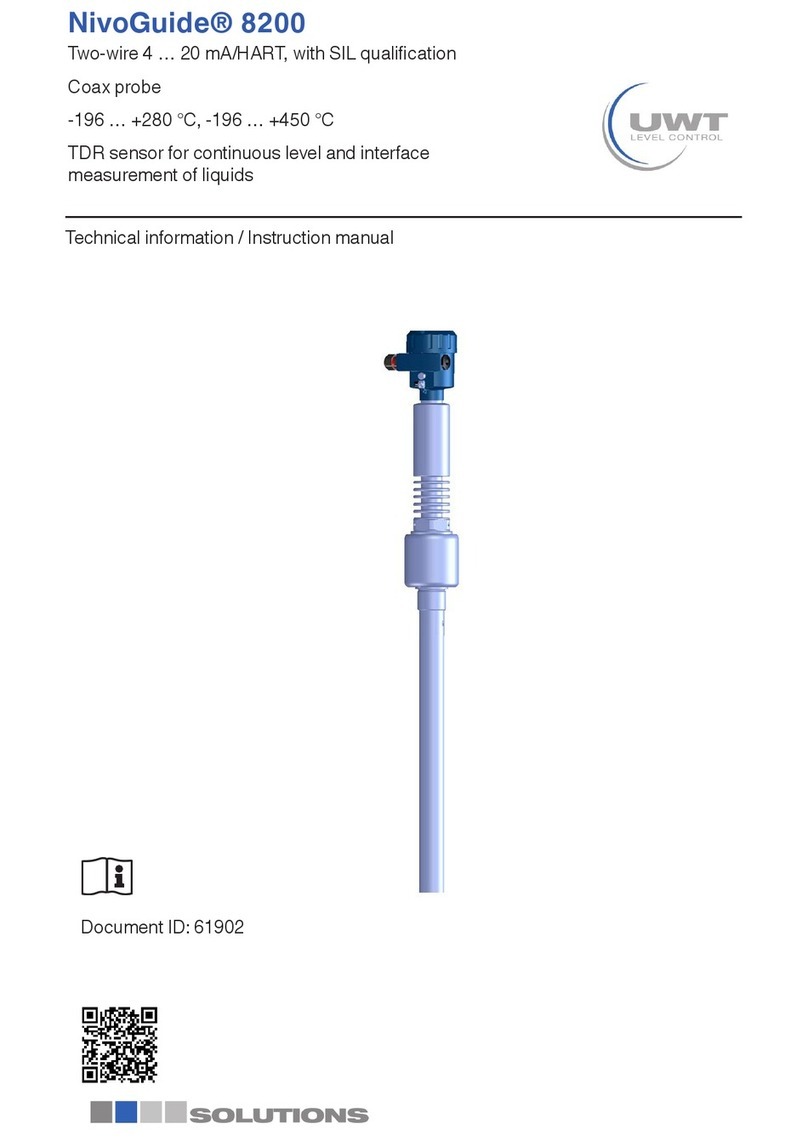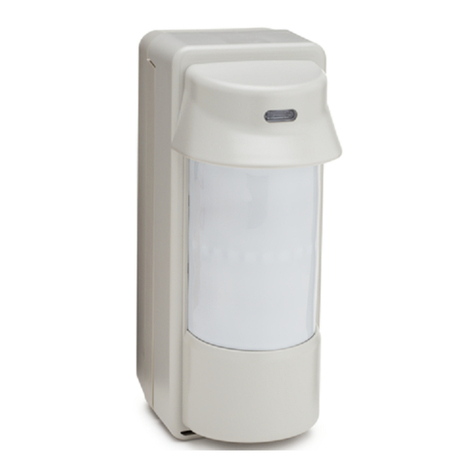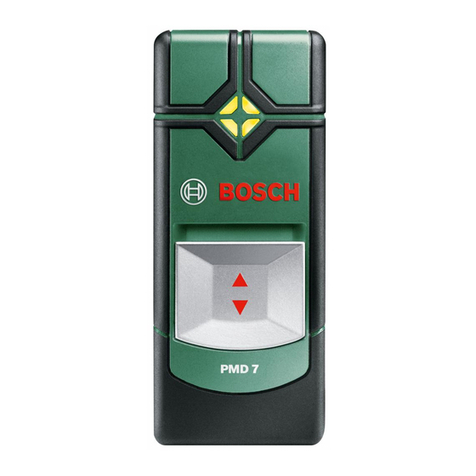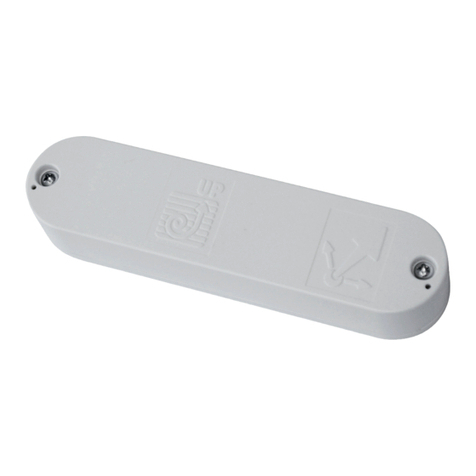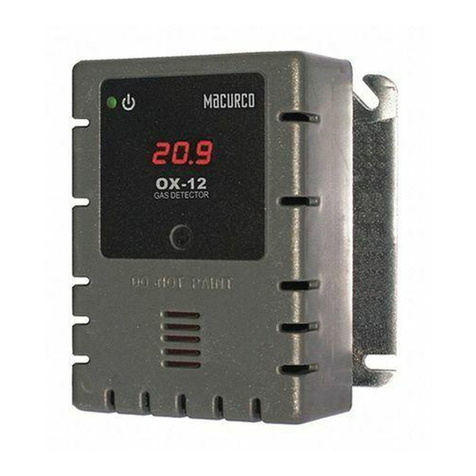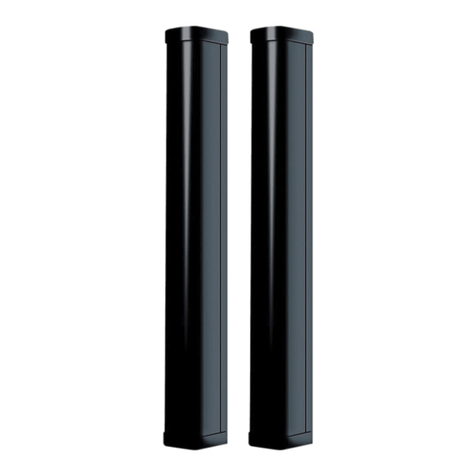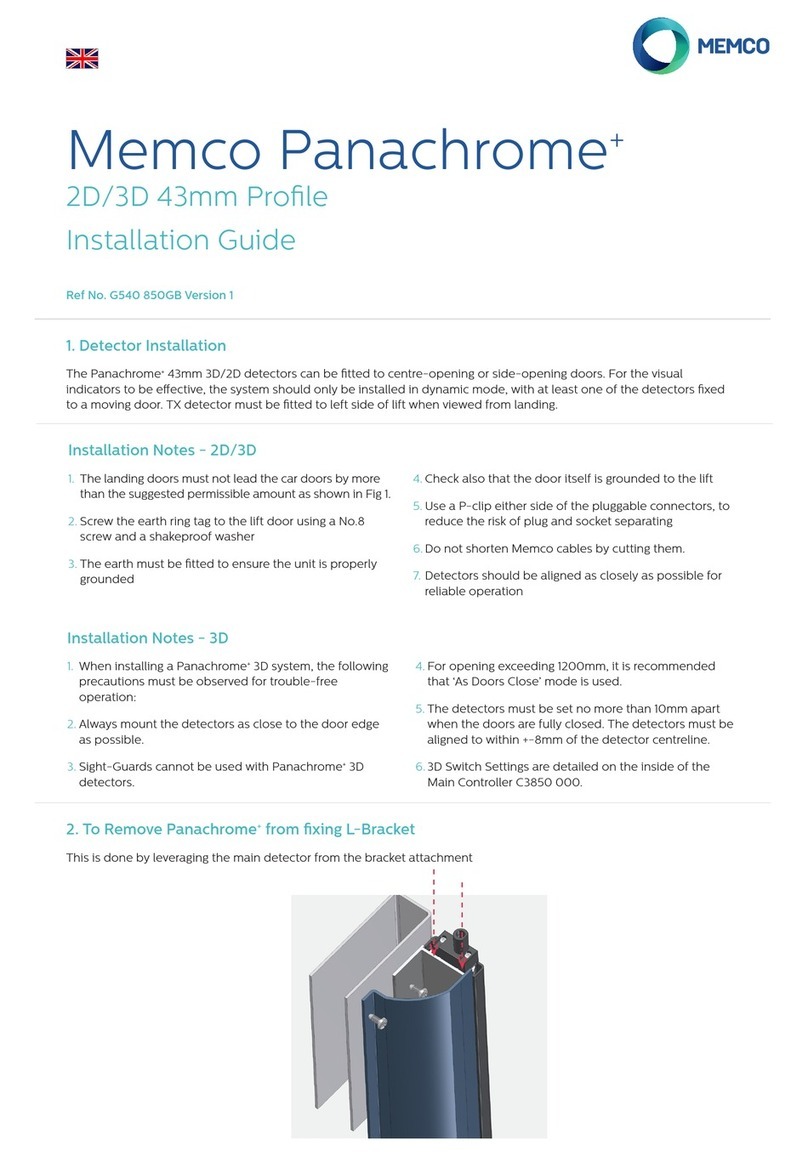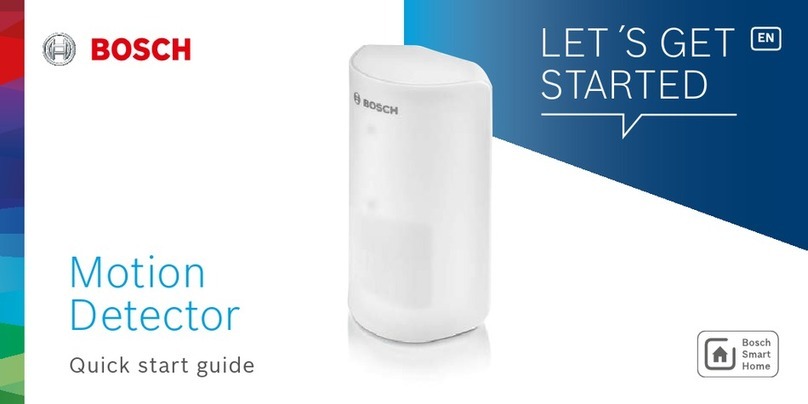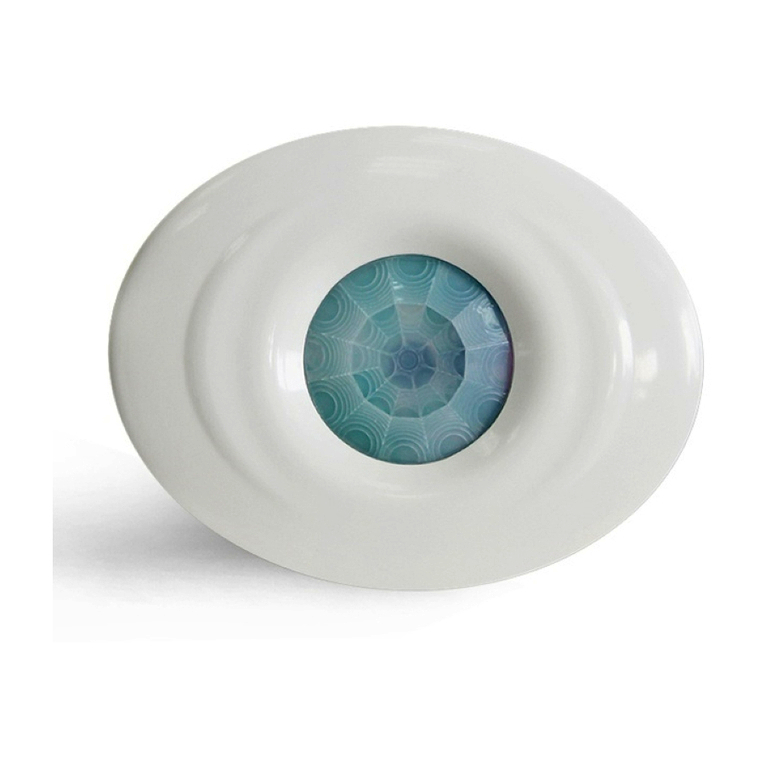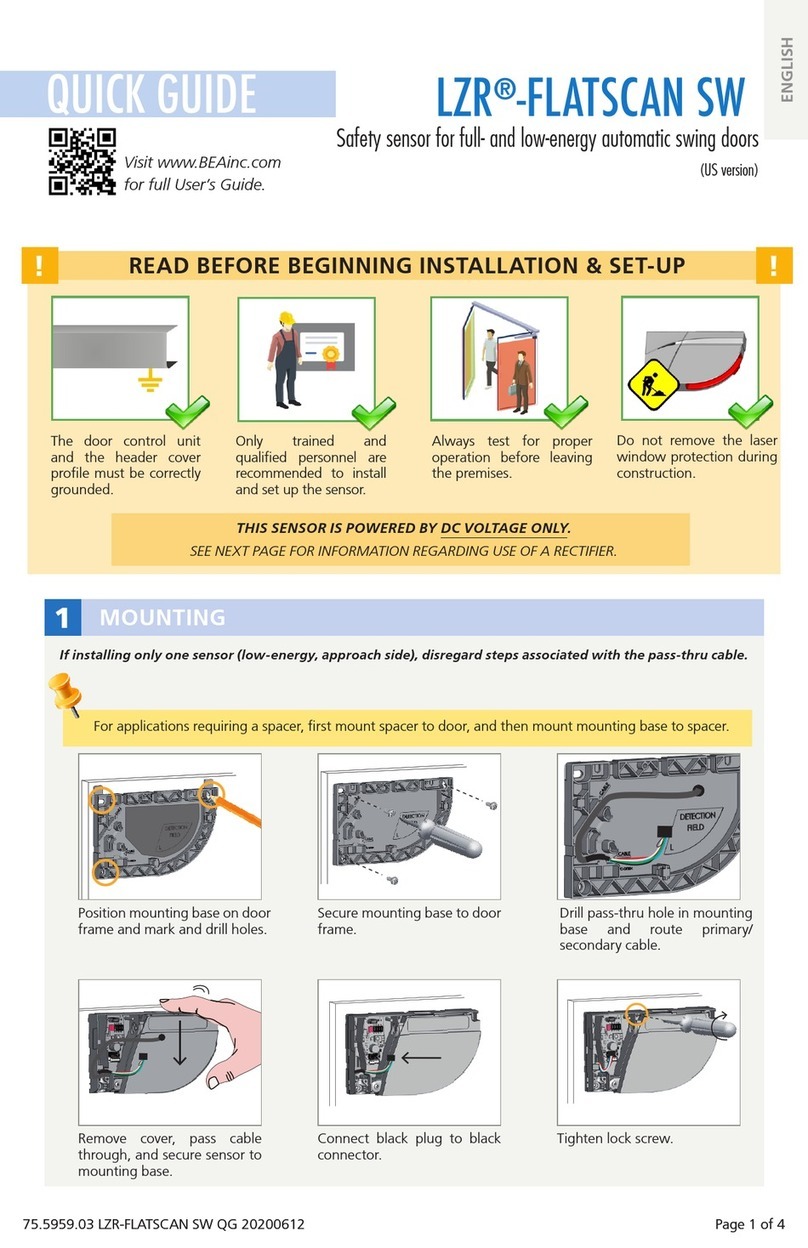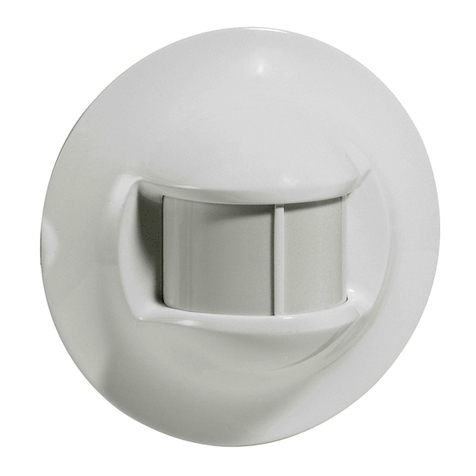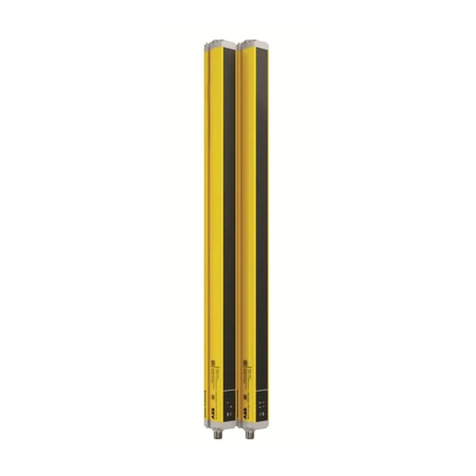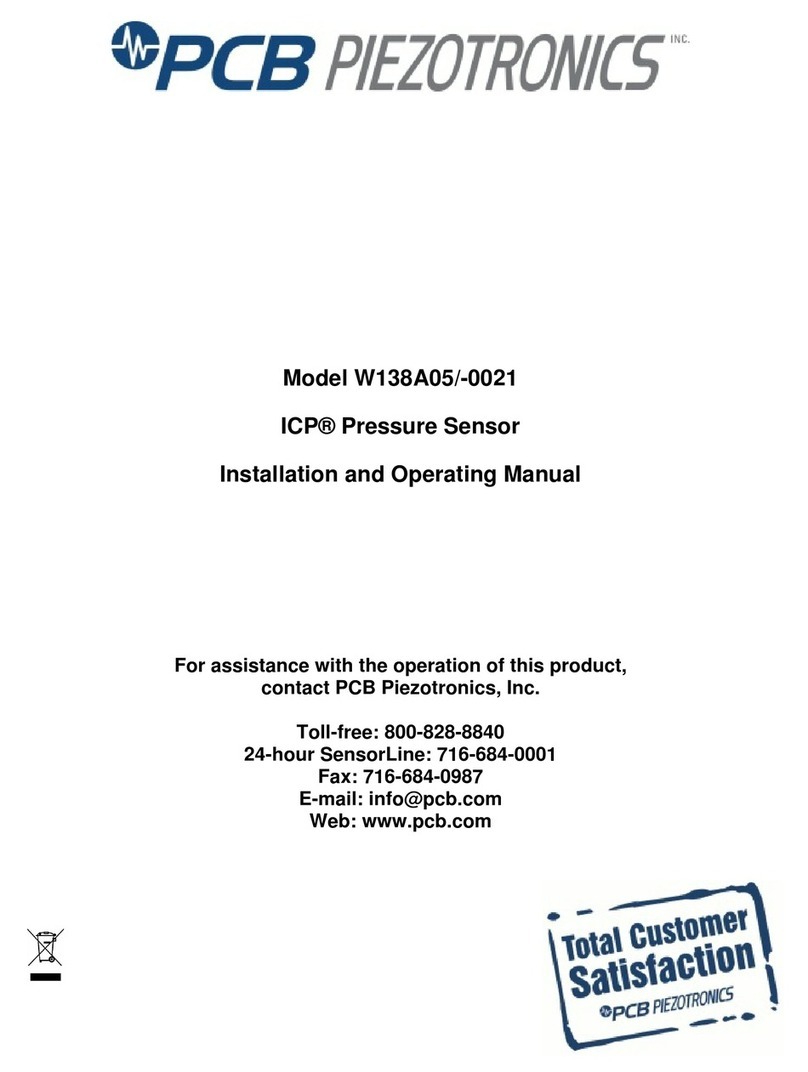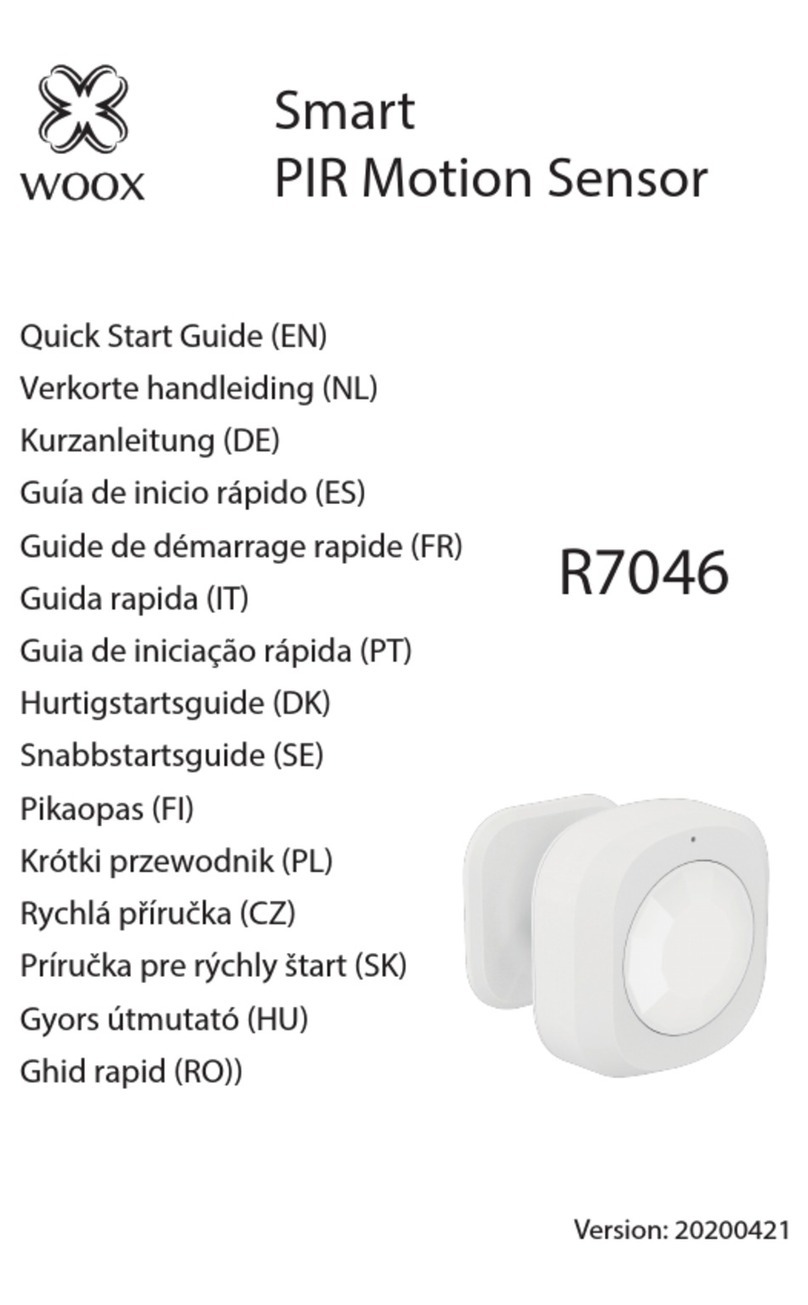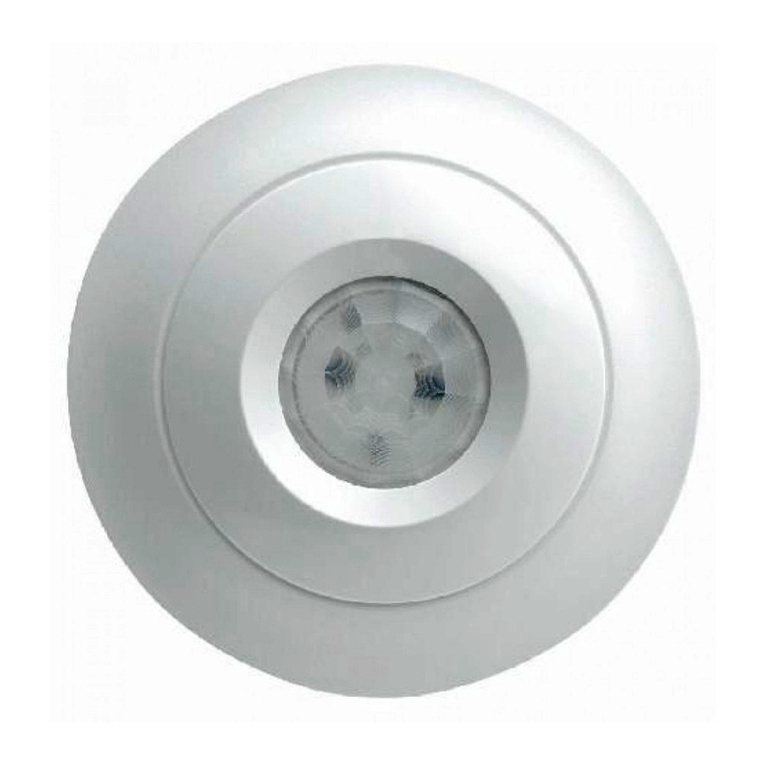Metrohm 896 User manual

IC Professional Detector
896 Professional Detector – Conductivity & Amperometry
Manual
8.896.8006EN


Metrohm AG
CH-9100 Herisau
Switzerland
Phone +41 71 353 85 85
Fax +41 71 353 89 01
www.metrohm.com
IC Professional Detector
896 Professional Detector – Conduc-
tivity & Amperometry
2.896.0030
Manual
8.896.8006EN 10.2012 zst

Teachware
Metrohm AG
CH-9100 Herisau
This documentation is protected by copyright. All rights reserved.
Although all the information given in this documentation has been
checked with great care, errors cannot be entirely excluded. Should you
notice any mistakes please send us your comments using the address
given above.
Documentation in additional languages can be found on
http://documents.metrohm.com.

■■■■■■■■■■■■■■■■■■■■■■ Table of contents
2.896.0030 896 Professional Detector – Conductivity & Amperometry ■■■■■■■■ III
Table of contents
1 Introduction 1
1.1 Instrument description ......................................................... 1
1.2 Intended use ......................................................................... 2
1.3 Safety instructions ................................................................ 2
1.3.1 General notes on safety ........................................................... 2
1.3.2 Electrical safety ........................................................................ 2
1.3.3 Tubing and capillary connections ............................................. 3
1.3.4 Flammable solvents and chemicals ........................................... 4
1.3.5 Recycling and disposal ............................................................. 4
1.4 About the documentation ................................................... 4
1.4.1 Content and scope .................................................................. 4
1.4.2 Symbols and conventions ........................................................ 5
2 Overview of the instrument 6
2.1 Front ...................................................................................... 6
2.2 Rear ........................................................................................ 8
3 Installation 9
3.1 Setting up the instrument .................................................... 9
3.1.1 Packaging ................................................................................ 9
3.1.2 Checks .................................................................................... 9
3.1.3 Location .................................................................................. 9
3.1.4 Proposed setup ........................................................................ 9
3.2 Mounting base tray and bottle holder (optional) ............ 10
3.2.1 Removing / mounting the base tray ....................................... 10
3.2.2 Removing / mounting the bottle holder ................................. 12
3.3 Conductivity detector ......................................................... 15
3.3.1 Connect the detector capillaries ............................................. 15
3.4 Amperometric detector ...................................................... 18
3.5 Connecting the instrument ................................................ 18
3.5.1 Connecting the instrument to the PC ..................................... 18
3.5.2 Connecting the instrument to power supply .......................... 18
4 Start-up 20
4.1 Instrument test with dummy cell ...................................... 20
4.2 Testing the leak sensor ...................................................... 22
4.3 Testing the preheating capillary ....................................... 22
4.4 Testing the detector output capillary ............................... 23

Table of contents ■■■■■■■■■■■■■■■■■■■■■■
IV ■■■■■■■■ 2.896.0030 896 Professional Detector – Conductivity & Amperometry
4.5 Testing the measuring cell ................................................. 25
4.6 Deaerating the measuring cell .......................................... 27
4.7 Connecting the electrode connection cables ................... 28
4.8 Attaching the front lid ....................................................... 30
5 Operation and maintenance 31
5.1 General notes ...................................................................... 31
5.1.1 Care ...................................................................................... 31
5.1.2 Maintenance by Metrohm Service .......................................... 31
5.1.3 Operation .............................................................................. 31
5.1.4 Shutting down ...................................................................... 32
5.2 Conductivity detector ......................................................... 32
5.2.1 Maintenance ......................................................................... 32
5.2.2 Remedying blockage ............................................................. 32
5.3 Amperometric detector ...................................................... 33
5.3.1 Maintenance ......................................................................... 33
5.3.2 Preheating capillary maintenance ........................................... 33
5.4 Quality Management and validation with Metrohm ....... 34
6 Troubleshooting 35
6.1 Problems with the hardware ............................................. 35
6.2 Problems with the baseline ............................................... 35
6.3 General remarks regarding sensitivity fluctuations ......... 38
6.4 Problems with sensitivity ................................................... 38
6.5 Problems with the pressure ............................................... 39
6.6 Problems with the measuring signal ................................ 39
6.7 Problems with the chromatogram .................................... 40
6.8 Other problems ................................................................... 41
6.9 Systematic error diagnostics ............................................. 42
7 Technical specifications 44
7.1 Reference conditions .......................................................... 44
7.2 Conductivity detector ......................................................... 44
7.3 Amperometric detector ...................................................... 45
7.4 Power connection ............................................................... 46
7.5 Leak sensor ......................................................................... 46
7.6 Ambient conditions ............................................................ 46
7.7 Housing ............................................................................... 47
7.8 Interfaces ............................................................................. 47

■■■■■■■■■■■■■■■■■■■■■■ Table of contents
2.896.0030 896 Professional Detector – Conductivity & Amperometry ■■■■■■■■ V
7.9 Safety specifications ........................................................... 47
7.10 Electromagnetic compatibility (EMC) ................................ 48
8 Warranty (Guarantee) 49
9 Accessories 51
9.1 Scope of delivery ................................................................ 51
9.2 Optional accessories ........................................................... 54
Index 59

Table of figures ■■■■■■■■■■■■■■■■■■■■■■
VI ■■■■■■■■ 2.896.0030 896 Professional Detector – Conductivity & Amperometry
Table of figures
Figure 1 Front – Front lid attached .................................................................. 6
Figure 2 Front – Front lid removed .................................................................. 7
Figure 3 Rear .................................................................................................. 8
Figure 4 Connection detector – separation column ....................................... 16
Figure 5 Connection detector – suppressor ................................................... 17
Figure 6 Connection detector – MCS ............................................................ 17

■■■■■■■■■■■■■■■■■■■■■■ 1 Introduction
2.896.0030 896 Professional Detector – Conductivity & Amperometry ■■■■■■■■ 1
1 Introduction
1.1 Instrument description
The 896 Professional Detector – Conductivity & Amperometry is
an intelligent Stand-Alone Detector equipped with a high-performance
conductivity detector and an amperometric detector.
As a stand-alone detector, it can for example be combined with instru-
ments of the 850 Professional IC family for which all available detector
connectors have already been assigned to conductivity detectors (AnCat
systems or other multi-channel systems) and be used for the determina-
tion of electroactive substances in the mobile phase.
Multiple detector installations can be implemented with the 896 Professio-
nal Detector – Conductivity & Amperometry, even with the instruments of
the Compact IC family (881 and 882) and with the 883 Basic IC plus,
which possess only one detector connector which would normally be
occupied by a conductivity detector. Applications can thus be carried out
that require not only conductivity detection but also amperometric detec-
tion.
The 896 Professional Detector – Conductivity & Amperometry is a stand-
alone detector that combines the advantages of the IC Conductivity
Detector and the IC Amperometric Detector with the combination oppor-
tunities of the 850 Professional IC instruments. It is directly controlled by
the MagIC Net™ software.
872 Extension Modules, 891 Analog Out and 800 Dosinos, Remote Boxes,
etc. can all be operated through the 896 Professional Detector – Conduc-
tivity & Amperometry. This opens up the flexibility of Metrohm IC systems
considerably.
The instrument is comprised of the following modules:
Conductivity detector
The conductivity detector continuously measures the conductivity of the
liquid passing through and indicates the measured values in digital form
(DSP – Digital Signal Processing). The conductivity detector exhibits out-
standing thermal stability and thus guarantees reproducible measuring
conditions.
Amperometric detector
With the 896 Professional Detector – Conductivity & Amperometry, elec-
troactive substances can be determined in the mobile phase of an IC sys-
tem. Amperometric methods are used for the determination, which com-

1.2 Intended use ■■■■■■■■■■■■■■■■■■■■■■
2■■■■■■■■ 2.896.0030 896 Professional Detector – Conductivity & Amperometry
bine an outstanding sensitivity with a high degree of selectivity. The instal-
led potentiostat generates the voltages for the direct current amperometry
(DC), for the pulse amperometry (PAD) and the flexible integrated pulse
amperometry (flexIPAD) as well as for the recording of cyclovoltammo-
grams. The installed preheating capillary ensures a constant eluent tem-
perature on the cell.
1.2 Intended use
The 896 Professional Detector – Conductivity & Amperometry is used as
an independent detector in an IC system. With its two different detector
types, it is used on the one hand for the precise measurement of conduc-
tivity during ion chromatography determination of anions and cations and
on the other hand for the determination of electroactive substances in the
mobile phase of an IC or general liquid chromatography system.
The present instrument is used for working with chemicals and flammable
samples. Usage of the 896 Professional Detector – Conductivity & Amper-
ometry therefore requires the user to have basic knowledge and experi-
ence in the handling of toxic and caustic substances. Knowledge with
respect to the application of the fire prevention measures prescribed for
laboratories is also mandatory.
1.3 Safety instructions
1.3.1 General notes on safety
Warning
This instrument may only be operated in accordance with the specifica-
tions in this documentation.
This instrument has left the factory in a flawless state in terms of technical
safety. To maintain this state and ensure non-hazardous operation of the
instrument, the following instructions must be observed carefully.
1.3.2 Electrical safety
The electrical safety when working with the instrument is ensured as part
of the international standard IEC 61010.
Warning
Only personnel qualified by Metrohm are authorized to carry out service
work on electronic components.

■■■■■■■■■■■■■■■■■■■■■■ 1 Introduction
2.896.0030 896 Professional Detector – Conductivity & Amperometry ■■■■■■■■ 3
Warning
Never open the housing of the instrument. The instrument could be
damaged by this. There is also a risk of serious injury if live components
are touched.
There are no parts inside the housing which can be serviced or replaced
by the user.
Mains voltage
Warning
An incorrect mains voltage can damage the instrument.
Only operate this instrument with a mains voltage specified for it (see
rear panel of the instrument).
Protection against electrostatic charges
Warning
Electronic components are sensitive to electrostatic charges and can be
destroyed by discharges.
Do not fail to pull the mains cable out of the mains connection socket
before you set up or disconnect electrical plug connections at the rear
of the instrument.
1.3.3 Tubing and capillary connections
Caution
Leaks in tubing and capillary connections are a safety risk. Tighten all
connections well by hand. Avoid applying excessive force to tubing
connections. Damaged tubing ends lead to leakage. Appropriate tools
can be used to loosen connections.
Check the connections regularly for leakage. If the instrument is used
mainly in unattended operation, then weekly inspections are manda-
tory.

1.4 About the documentation ■■■■■■■■■■■■■■■■■■■■■■
4■■■■■■■■ 2.896.0030 896 Professional Detector – Conductivity & Amperometry
1.3.4 Flammable solvents and chemicals
Warning
All relevant safety measures are to be observed when working with
flammable solvents and chemicals.
■Set up the instrument in a well-ventilated location (e.g. fume cup-
board).
■Keep all sources of flame far from the workplace.
■Clean up spilled liquids and solids immediately.
■Follow the safety instructions of the chemical manufacturer.
1.3.5 Recycling and disposal
This product is covered by European Directive 2002/96/EC, WEEE – Waste
from Electrical and Electronic Equipment.
The correct disposal of your old equipment will help to prevent negative
effects on the environment and public health.
More details about the disposal of your old equipment can be obtained
from your local authorities, from waste disposal companies or from your
local dealer.
1.4 About the documentation
Caution
Please read through this documentation carefully before putting the
instrument into operation. The documentation contains information
and warnings which the user must follow in order to ensure safe opera-
tion of the instrument.
1.4.1 Content and scope
This document describes the 896 Professional Detector – Conductiv-
ity & Amperometry, its assembly and connection to the IC instrument,
as well as the installation, operation and maintenance of the individual
components. Technical specifications, troubleshooting and information
concerning scope of delivery and optional accessories make up the rest of
the manual.
You will find additional information on the installation and maintenance
of the IC instrument and the Sample Processor in the respective manuals.

■■■■■■■■■■■■■■■■■■■■■■ 1 Introduction
2.896.0030 896 Professional Detector – Conductivity & Amperometry ■■■■■■■■ 5
Additional information for configuration and operation with MagIC Net™
can be found in the "Tutorial for MagIC Net™" or in the MagIC Net™
online help.
1.4.2 Symbols and conventions
The following symbols and formatting may appear in this documentation:
Cross-reference to figure legend
The first number refers to the figure number, the sec-
ond to the instrument part in the figure.
Instruction step
Carry out these steps in the sequence shown.
Method Dialog text, parameter in the software
File ▶ New Menu or menu item
[Next] Button or key
Warning
This symbol draws attention to a possible life hazard
or risk of injury.
Warning
This symbol draws attention to a possible hazard due
to electrical current.
Warning
This symbol draws attention to a possible hazard due
to heat or hot instrument parts.
Warning
This symbol draws attention to a possible biological
hazard.
Caution
This symbol draws attention to a possible damage of
instruments or instrument parts.
Note
This symbol marks additional information and tips.

2.1 Front ■■■■■■■■■■■■■■■■■■■■■■
6■■■■■■■■ 2.896.0030 896 Professional Detector – Conductivity & Amperometry
2 Overview of the instrument
2.1 Front
23
1
4 5 678
Figure 1 Front – Front lid attached
1Power LED
Amperometric detector standby indicator.
2Amperometric detector
Permanently installed.
3Conductivity detector
Permanently installed.
4Power LED
Standby indicator instrument.
5Front lid
For the amperometric detector.
6Knurled screw
For removing the front lid.
7Coupling
Connector for the eluent output capillary of
the conductivity detector. Labeled with
Cond. Eluent out.
8Detector input capillary
Of the conductivity detector. Permanently
mounted.

■■■■■■■■■■■■■■■■■■■■■■ 2 Overview of the instrument
2.896.0030 896 Professional Detector – Conductivity & Amperometry ■■■■■■■■ 7
12345
678109
Figure 2 Front – Front lid removed
1Auxiliary electrode socket
For connecting the auxiliary electrode.
Labeled with AE.
2Power LED
Amperometric detector standby indicator.
3Cell holder
With chip for the automatic detection of the
measuring cell.
4Working electrode socket
For connecting the working electrode.
Labeled with WE.
5Reference electrode socket
For connecting the reference electrode.
Labeled with RE.
6Coupling
For connecting one connection capillary to
the measuring cell. Labeled with Eluent to
cell.
7Tray 8Drain nozzle
For draining liquid from the tray. Plugged
with a stopper.
9Thread
For the knurled screw used for fastening the
front lid.
10 Coupling
For connecting the detector input capillary.
Labeled with Eluent in.

2.2 Rear ■■■■■■■■■■■■■■■■■■■■■■
8■■■■■■■■ 2.896.0030 896 Professional Detector – Conductivity & Amperometry
2.2 Rear
1234567
8910
Figure 3 Rear
1Cable feed-through
Outlet for detector cable.
2Cable feed-through
Outlet for detector cable.
3PC connection socket
For connecting the instrument to the com-
puter with the USB cable (6.2151.020).
4USB connection sockets
Two USB connection sockets, labeled with
USB 1 and USB 2.
5Extension Module connection socket
For connecting an 872 Extension Module or
an 891 Professional Analog Out. Labeled
with Extension Module.
6Detector connection sockets
For the connection of the installed detector,
labeled with Detector 1 and Detector 2.
The detector connection sockets which are
not used must be covered with a lid.
7Leak sensor connection socket
For connecting the
Leak sensor connector plug, labeled with
Leak Sensor.
8Mains switch
For switching the instrument on and off.
9Mains cable connection socket
For connecting the mains cable
(6.2122.0x0).
10 MSB connection sockets
Two MSB connection sockets for connecting
instruments with MSB connection, labeled
with MSB 1 and MSB 2.
(MSB = Metrohm Serial Bus)

■■■■■■■■■■■■■■■■■■■■■■ 3 Installation
2.896.0030 896 Professional Detector – Conductivity & Amperometry ■■■■■■■■ 9
3 Installation
3.1 Setting up the instrument
3.1.1 Packaging
The instrument is supplied in highly protective special packaging together
with the separately packed accessories. Keep this packaging, as only this
ensures safe transportation of the instrument.
3.1.2 Checks
Immediately after receipt, check whether the shipment has arrived com-
plete and without damage by comparing it with the delivery note.
3.1.3 Location
The instrument has been developed for operation indoors and may not be
used in explosive environments.
Place the instrument in a location of the laboratory which is suitable for
operation and free of vibrations and which provides protection against
corrosive atmosphere and contamination by chemicals.
The instrument should be protected against excessive temperature fluctu-
ations and direct sunlight.
The distance between the rear of the instrument and the wall must be
large enough to secure air circulation on the cooling plate.
3.1.4 Proposed setup
One option is to install the 896 Professional Detector – Conductivity &
Amperometry directly above an 850 IC instrument. To accomplish this, the
bottle holder of the IC instrument must be removed and then be placed
back on the 896 Professional Detector – Conductivity & Amperometry (see
Chapter 3.2, page 10).
The other option is to position the 896 Professional Detector – Conductiv-
ity & Amperometry directly underneath the 850 IC instrument. To accom-
plish this, the base tray of the IC instrument must be removed and then be
placed back on underneath the 896 Professional Detector – Conductivity
& Amperometry (see Chapter 3.2, page 10).
As an alternative, the 896 Professional Detector – Conductivity & Amper-
ometry can be set up together with other instruments using the same sup-
port surface in one separate stack next to the IC instrument. We recom-
mend that one bottle holder (6.2061.100) and one base tray (6.2061.110)
be mounted for each stack of IC instruments.

3.2 Mounting base tray and bottle holder (optional) ■■■■■■■■■■■■■■■■■■■■■■
10 ■■■■■■■■ 2.896.0030 896 Professional Detector – Conductivity & Amperometry
If a 896 Professional Detector – Conductivity & Amperometry is to be set
up underneath an 881 Compact IC pro or an 882 Compact IC plus, then
the System Connector (6.2061.120) must be used instead of the base tray
of the IC instrument; this adjusts the larger surface area of the 896 Profes-
sional Detector – Conductivity & Amperometry to the smaller surface area
of the 881 or 882, respectively.
The 896 Professional Detector – Conductivity & Amperometry cannot be
set up above an 881 Compact IC pro or an 882 Compact IC plus.
3.2 Mounting base tray and bottle holder (optional)
The 6.2061.110 base tray and 6.2061.100 bottle holder protect IC instru-
ments from dust, dirt and leaking fluids. If more than one instrument of
the Professional IC family is used, these can be set up in one or more
stacks. We recommend that a base tray and a bottle holder be mounted
for each stack of IC instruments.
Bottle holder and base tray must be removed or mounted every time one
of the following instruments is to be mounted on or under an 850 Profes-
sional IC instrument:
■One or more 872 Extension Module.
■An 887 Professional UV/VIS Detector.
■An 896 Professional Detector.
■or another instrument of the same support surface.
3.2.1 Removing / mounting the base tray
The base tray must be removed, in case you want to place another instru-
ment under the IC instrument. Proceed as follows:
Removing the base tray
Before you can remove the base tray, the following preconditions must be
met:
■The instrument is switched off.
■The bottle holder is cleared.
■All connections at the rear of the instrument are disconnected.
■There are no loose parts in the instrument.
To remove the base tray, you need a 3 mm hexagon key (6.2621.100).

■■■■■■■■■■■■■■■■■■■■■■ 3 Installation
2.896.0030 896 Professional Detector – Conductivity & Amperometry ■■■■■■■■ 11
123
1Tilt the instrument sideways and lay it down flat.
2Loosen the cylinder screws with the 3 mm hexagon key and remove
them and their washers.
3Remove the base tray.
The base tray must always be mounted under the lowermost instrument
of the stack. Proceed as follows:
Mounting the base tray
Before you can mount the base tray, the following preconditions must be
met:
■The instrument is switched off.
■The bottle holder is cleared.
■All connections at the rear of the instrument are disconnected.
■There are no loose parts in the instrument.
■The instrument is lying on it side, and the bottom surface is visible.
To mount the base tray, you need a 3 mm hexagon key (6.2621.100).

3.2 Mounting base tray and bottle holder (optional) ■■■■■■■■■■■■■■■■■■■■■■
12 ■■■■■■■■ 2.896.0030 896 Professional Detector – Conductivity & Amperometry
13
2
1Place the base tray in such a way that the openings in the base tray
match exactly the screw threads in the bottom of the instrument.
2Slide the four washers onto the four cylinder screws, insert the
screws and tighten them with the 3 mm hexagon key.
3Set the instrument up on the base tray.
Stack other instruments in the required order. Mount the bottle holder
(6.2061.100) onto the topmost instrument on the stack (see "Mounting
the bottle holder", page 13).
3.2.2 Removing / mounting the bottle holder
The bottle holder must be removed in case you want to mount another
instrument on top of the IC instrument. Proceed as follows:
Removing the bottle holder
Before you can remove the bottle holder, the following preconditions
must be met:
■The instrument is switched off.
■The bottle holder is cleared.
■Drainage tubing is disconnected from the drainage tubing connection
of the bottle holder.
To remove the bottle holder, you need a 3 mm hexagon key
(6.2621.100).
Table of contents
Other Metrohm Security Sensor manuals
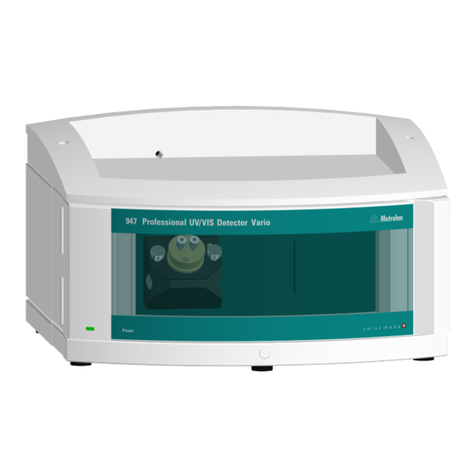
Metrohm
Metrohm Vario-SW 947 Series User manual
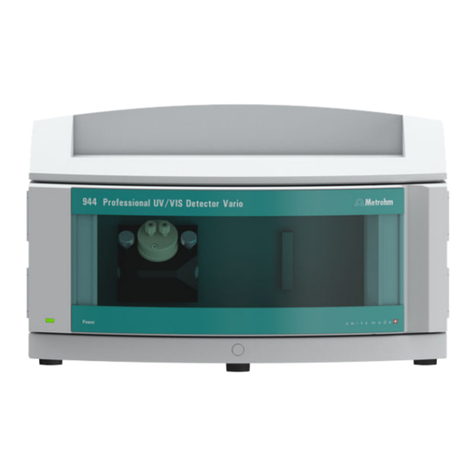
Metrohm
Metrohm 944 User manual

Metrohm
Metrohm 887 User manual

Metrohm
Metrohm 945 Professional Detector Vario User manual
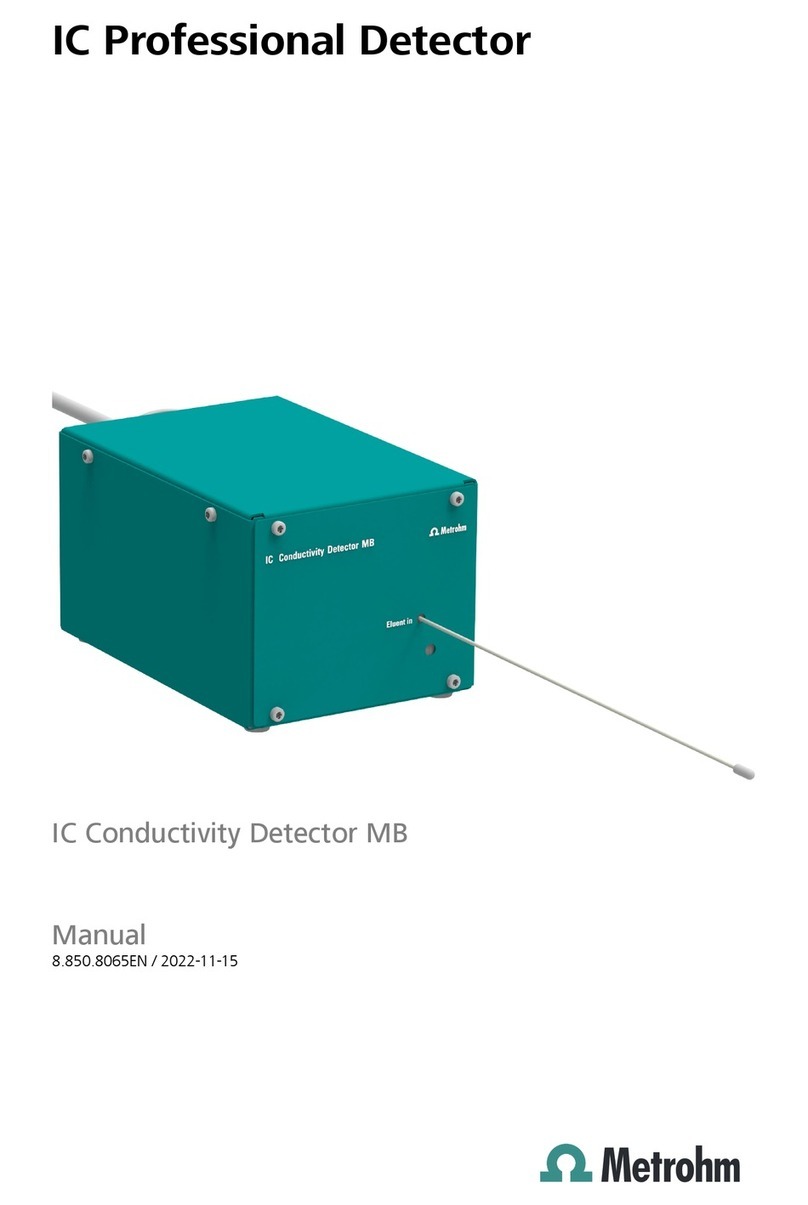
Metrohm
Metrohm MB User manual
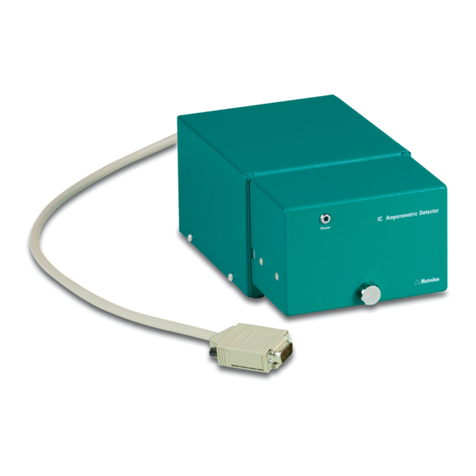
Metrohm
Metrohm IC Amperometric Detector User manual
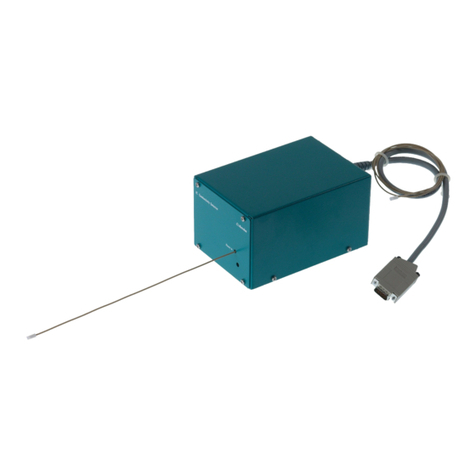
Metrohm
Metrohm IC Conductivity Detector User manual

Metrohm
Metrohm IC Conductivity Detector User manual
